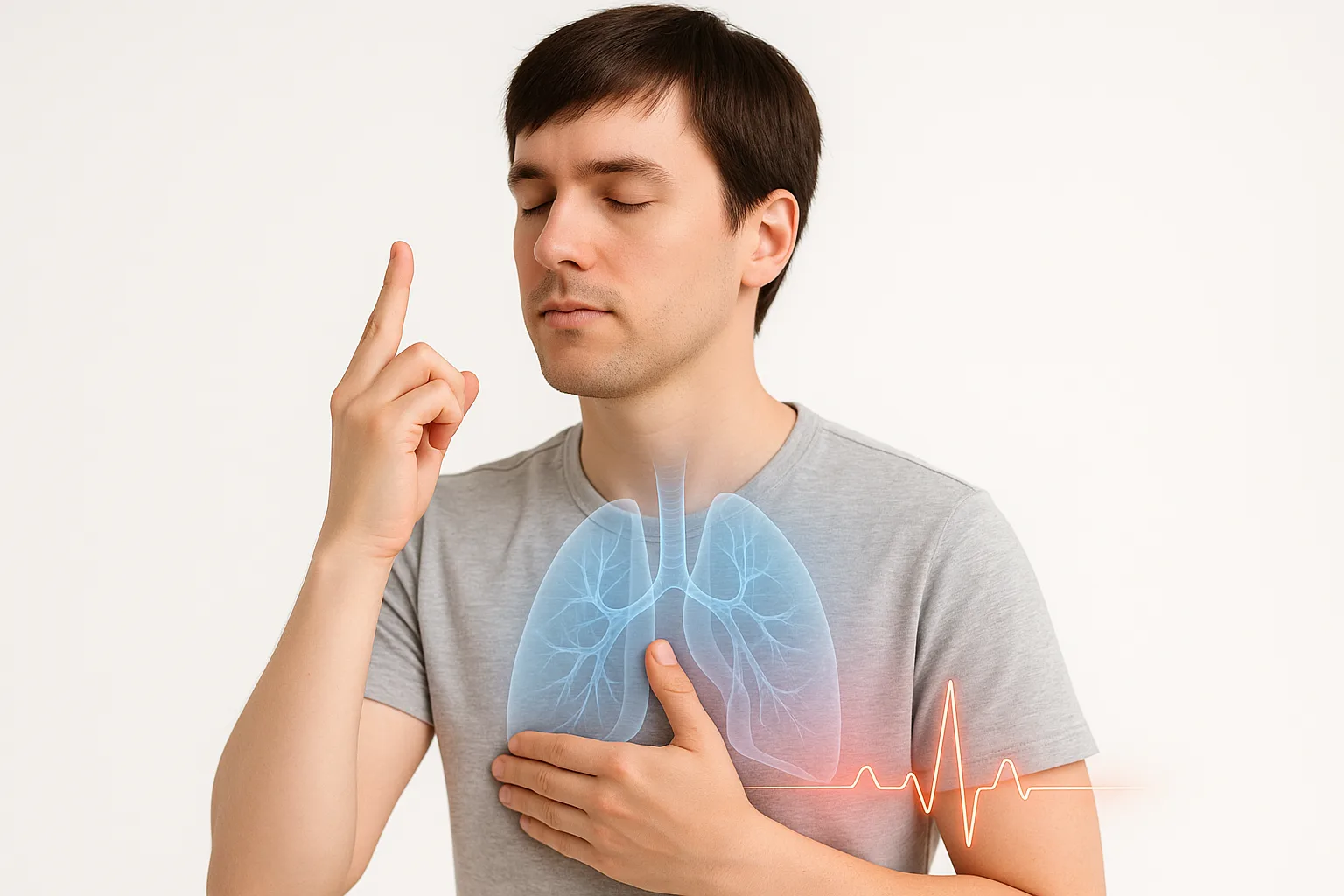Your heart rate changes every time you breathe — literally every single inhale and exhale.
Your nervous system adjusts your pulse rhythm instantly to match your breathing pattern, even when you’re sitting still.
This breath-to-heartbeat sync test shows how your heartbeat responds in real time to your breath — something most people have never consciously felt.
You’ll experience your heart:
- slowing down
- speeding up
- stabilizing
- syncing with your lungs
All in 30 seconds.
Let’s begin.
Step 1 — Sit Still and Count Your Natural Heartbeat
Before changing anything, you need a baseline.
Sit comfortably.
Relax your shoulders.
Close your eyes if that helps.
Now focus on your heartbeat using:
- chest sensation
- abdomen vibration
- inner-ear pulse
- or neck pressure
Count your heartbeat for 10 seconds.
Multiply by 6 to get your current BPM.
What this shows
This is your resting breath-pulse state, the foundation of the breath-to-heartbeat sync test.
Step 2 — Inhale Slowly for 5 Seconds and Feel the Heart Speed Up
Take a deep, slow breath:
Inhale for 5 seconds
1… 2… 3… 4… 5…
As you inhale, your heartbeat slightly speeds up.
Why this happens
When you inhale:
- your lungs expand
- your chest pressure drops
- your heart pumps faster to maintain circulation
- vagus nerve activity decreases
- sympathetic activation increases
This natural acceleration is called respiratory sinus arrhythmia, and it’s one of the clearest ways to feel mind-body connection.
Step 3 — Exhale Slowly for 5 Seconds and Feel the Heart Slow Down
Now exhale gently:
Exhale for 5 seconds
1… 2… 3… 4… 5…
During exhale, your heartbeat slows down.
Why
Exhaling increases vagus nerve activity —
the nerve responsible for calmness, relaxation, and digestion.
Your body enters a mini “rest mode,”
so your heart rate drops instantly.
This is the core of the breath-to-heartbeat sync test.
Step 4 — Repeat the Cycle 3 Times and Feel the Sync Happen
Now try this:
- Inhale 5 seconds
- Exhale 5 seconds
- Repeat for 3 full cycles
What you’ll feel
With each cycle:
- heartbeat gets smoother
- rhythm becomes predictable
- breath and pulse move together
- internal awareness increases
- calmness rises
The sync becomes stronger the more cycles you do.
You’re literally controlling your heartbeat with breath.

Step 5 — Try Counting Your Heartbeat ONLY During Exhale
This is where awareness deepens.
Exhale slowly for 5–7 seconds
and count only during exhale.
What you’ll discover
You can feel your heartbeat more clearly during exhaling because:
- the heart slows
- the pulse is more pronounced
- the rhythm becomes more stable
This phase creates the clearest moment in the breath-to-heartbeat sync test.
Step 6 — Compare Heartbeat Between Inhale and Exhale
Now do this:
Inhale
Notice your heartbeat — faster, lighter.
Exhale
Notice your heartbeat — slower, deeper.
What you’re experiencing
Two completely different cardiovascular states happening within seconds — controlled by nothing but your breath.
This is one of the most fascinating biological mechanisms you can feel without any equipment.
Step 7 — Introduce the “Extended Exhale Method”
Now exaggerate the effect.
Try:
- Inhale 4 seconds
- Exhale 8 seconds
Why this is powerful
Long exhale =
strong vagus nerve activation.
The longer the exhale, the stronger the:
- heartbeat slowing
- calming response
- blood pressure drop
- parasympathetic activation
This is used in meditation, stress reduction, and athletic recovery.
The breath-to-heartbeat sync test reveals it instantly.
Step 8 — Try the “Fast Breath Acceleration” Variation
Now let’s speed things up.
Take 5 quick breaths in a row:
- short inhales
- short exhales
- 1 second each
Feel what happens
Your heartbeat:
- speeds up
- sharpens
- becomes more noticeable
- intensifies rhythm
Your body prepares for action — the sympathetic system kicks in.
You just felt real-time cardiovascular acceleration.
Step 9 — Test Advanced Sync With “Box Breathing”
Now try this pattern:
- Inhale 4s
- Hold 4s
- Exhale 4s
- Hold 4s
This makes the effect even clearer.
Why this works
Each phase influences heart rate:
- inhale → faster
- hold → tension = slight speed
- exhale → slower
- hold → calm pause
This creates a wave-like heartbeat pattern that aligns with your breath cycles.
Step 10 — What This Experiment Reveals About You
This single test offers powerful insights:
1. Vagus nerve sensitivity
Stronger heartbeat slowing = stronger vagal tone.
2. Stress response
If the heart barely slows → stress may be high.
If it slows deeply → your calm system is active.
3. Breath control
Your breathing efficiency affects heart rate instantly.
4. Cardiovascular flexibility
Rapid change = healthy nervous system.
Slow change = lower flexibility.
5. Interoception (body awareness)
The clearer you feel changes, the sharper your internal awareness is.
6. Mind–body connection
You can literally control heart rate with breath — this test proves it.
The breath-to-heartbeat sync test reveals how responsive and intelligent your cardiovascular system is.
Try the Next 30-Second Experiment
The Peripheral Vision Reflex Test — See How Fast You Detect Motion
